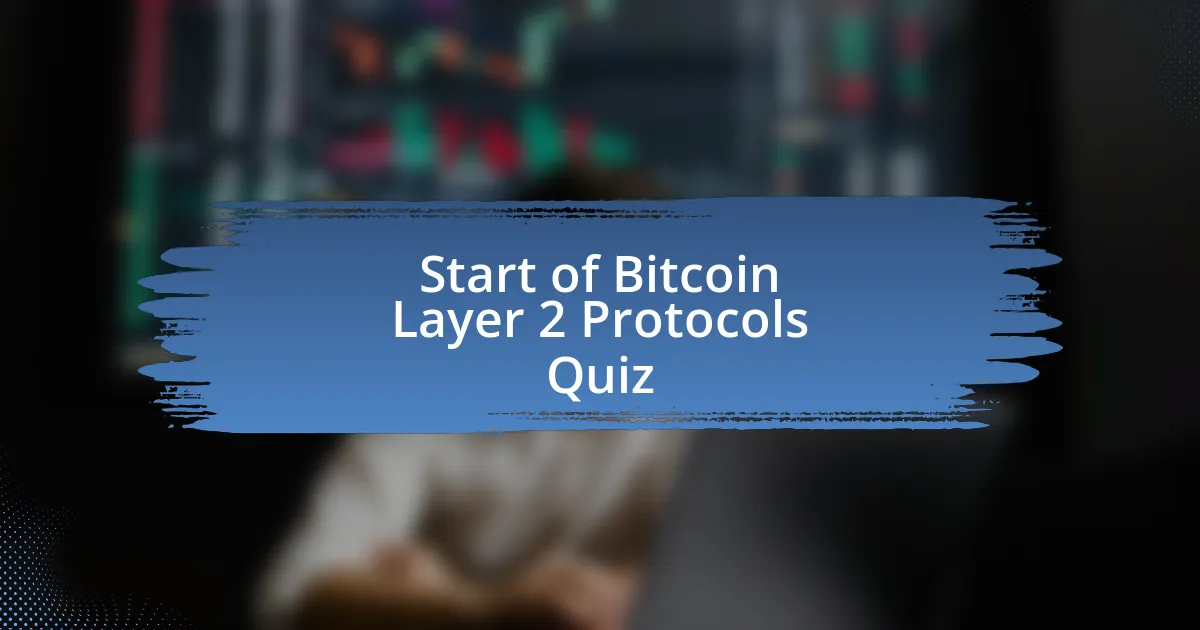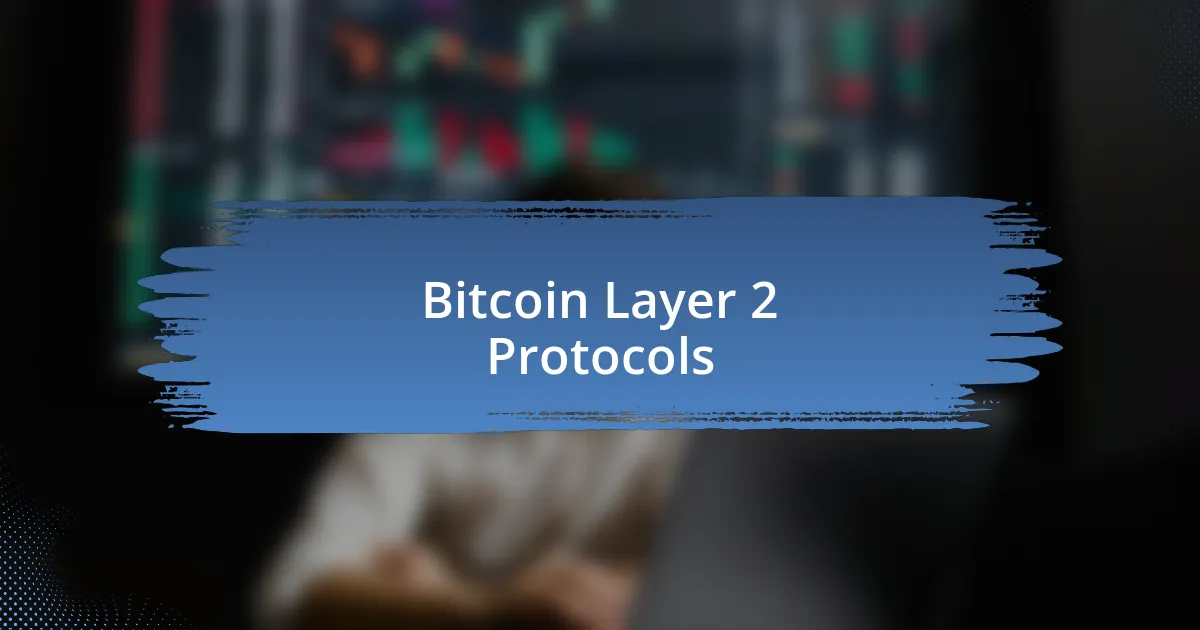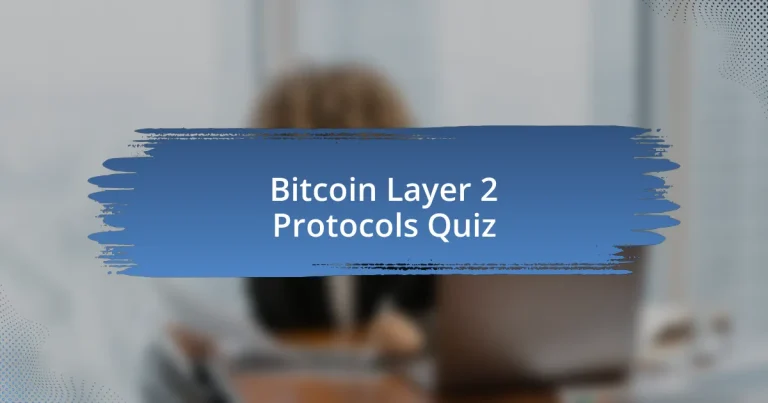
Start of Bitcoin Layer 2 Protocols Quiz
1. What is a Bitcoin layer 2?
- A way to create new types of Bitcoin.
- Any off-chain network, system, or technology built on top of the Bitcoin blockchain to extend its capabilities.
- A special wallet for storing Bitcoin securely.
- A method for mining more Bitcoin quickly.
2. Why is scaling the Bitcoin blockchain directly not an option?
- The Bitcoin blockchain is already too fast for scaling.
- It has too few users to justify changes to the blockchain.
- It would require compromising either security or decentralization per the blockchain scalability trilemma.
- Scaling is only needed for centralized systems, not blockchain.
3. What is the average transaction throughput of the Bitcoin network?
- Fifteen transactions per second (TPS).
- Three transactions per second (TPS).
- Seven transactions per second (TPS).
- Fifty transactions per second (TPS).
4. How do Bitcoin layer 2s increase transaction throughput?
- By introducing new consensus algorithms on the main chain.
- By processing transactions off-chain and then settling them on the main chain.
- By increasing the block size on the Bitcoin blockchain.
- By eliminating the need for transaction fees altogether.
5. What is the primary requirement for a network to be considered a Bitcoin layer 2?
- It must process all transactions on-chain.
- It must inherit the security of the Bitcoin blockchain.
- It must have its own native cryptocurrency.
- It must operate independently of the Bitcoin network.
6. What is the purpose of cryptographic proof in Bitcoin layer 2s?
- To verify and confirm the integrity of proposed state changes to the blockchain.
- To anonymize all user identities on the network.
- To enhance the complexity of transactions performed.
- To increase the transaction fees for all users.
7. What is a Bitcoin layer 2 rollup?
- A rollup is a type of wallet that stores Bitcoin securely online.
- A rollup is a centralized exchange for trading Bitcoin and altcoins.
- A rollup moves transaction execution and data off the main Bitcoin blockchain to a separate rollup chain or layer while still anchoring to Bitcoin for data availability and consensus.
- A rollup refers to a method for directly scaling the Bitcoin blockchain`s block size.
8. How do rollups process transactions?
- Rollups execute transactions in a centralized server environment.
- Rollups execute transactions on the rollup chain, compress data, and anchor to the Bitcoin mainnet.
- Rollups process transactions directly on the Bitcoin blockchain.
- Rollups rely solely on manual transaction verification without any cryptography.
9. What is the purpose of compressing transaction data in rollups?
- To erase unnecessary data from the main ledger.
- To create a compact cryptographic proof representing the net effect of all transactions.
- To enable unlimited transaction sizes within limit.
- To compress the blockchain into a single transaction.
10. How are rollup proofs verified on the Bitcoin blockchain?
- The compressed proof is periodically submitted to the Bitcoin blockchain as a single transaction.
- Rollup proofs are verified by external or centralized authorities.
- Rollups validate all transactions on the Bitcoin blockchain for security.
- The proof is checked by miners directly verifying each individual transaction.
11. What are the advantages of Bitcoin layer 2s?
- Greater scalability, reduced fees, programmable smart contracts, and deeper liquidity.
- Lower energy consumption and increased mining rewards.
- Enhanced graphics capabilities for transaction processing.
- Faster block creation times on the Bitcoin blockchain.
12. What is the Lightning Network?
- The Lightning Network is a mining protocol that increases Bitcoin transaction speeds directly on the blockchain.
- The Lightning Network is a storage solution that keeps Bitcoin secure on the main chain.
- The Lightning Network is a layer 2 application for Bitcoin that enables two parties to transfer coins through an off-chain channel, bypassing the main blockchain.
- The Lightning Network is a centralized exchange for trading Bitcoin with other cryptocurrencies.
13. How does the Lightning Network work?
- It relies solely on the security of a centralized server for transaction validation and processing.
- All transactions are executed and recorded on-chain simultaneously with no private channel use.
- Transactions are processed directly on the Bitcoin blockchain with no off-chain components.
- Users create private payment channels for off-chain transactions, with final balances recorded on-chain.
14. What are state channels in Bitcoin layer 2s?
- State channels are central banking systems for Bitcoin.
- State channels are public networks for high-cost transactions.
- State channels are hardware wallets for securing Bitcoin.
- State channels are private off-chain channels for low-cost transactions.
15. How do state channels handle transactions?
- State channels process all transactions on the main Bitcoin blockchain.
- Transactions in state channels are immediately recorded on-chain after each one.
- Users within a state channel can make multiple transactions off-chain.
- State channels require users to wait for each transaction to be confirmed on-chain.
16. What are the two main types of rollups?
- Centralized rollups and decentralized rollups
- Optimistic rollups and zero-knowledge (ZK) rollups
- Layer 1 and layer 3 rollups
- Proof-of-stake and proof-of-work
17. How do optimistic rollups handle transactions?
- Transactions are considered valid unless challenged by a fraud-proof.
- Only transactions under a certain amount are processed off-chain.
- All transactions are immediately accepted with no verification.
- Transactions must be confirmed by multiple third parties before execution.
18. How do zero-knowledge (ZK) rollups handle transactions?
- They rely on consensus mechanisms to process every transaction on-chain.
- They handle transactions by broadcasting all details to all network participants for transparency.
- They use cryptographic proofs to validate transaction legitimacy without revealing details.
- They conduct transactions directly on the Bitcoin blockchain without any additional layers.
19. What is the purpose of sidechains in Bitcoin layer 2s?
- Sidechains add encryption to the main blockchain.
- Sidechains bring scalability to the mainnet.
- Sidechains increase the fees for transactions on the mainnet.
- Sidechains make the Bitcoin network completely centralized.
20. What are the benefits of using sidechains?
- They reduce the cost of Bitcoin transactions.
- They centralize transaction validation.
- They eliminate the need for miners.
- They expand the maximum block size.
21. What is the difference between decentralized and centralized layer 2s?
- Centralized layer 2s do not require any security measures.
- Decentralized layer 2s maintain security while centralized may not.
- Decentralized layer 2s are managed by a single authority.
- Centralized layer 2s are faster and always more secure.
22. What is the most well-known layer 2 for Bitcoin?
- Optimistic Rollup
- The Liquid Network
- RIF Rollup
- The Lightning Network
23. What is the primary function of the Lightning Network?
- To create a decentralized marketplace for Bitcoin trading.
- To develop a new consensus mechanism for Bitcoin transactions.
- To provide a secure storage solution for Bitcoin wallets.
- To reduce the amount of traffic passing via the primary Bitcoin blockchain by enabling off-chain transactions.
24. What is the Liquid Network?
- The Liquid Network is a mobile wallet application for Bitcoin users.
- The Liquid Network is a new cryptocurrency created by Blockstream.
- The Liquid Network is a decentralized exchange for Bitcoin transactions.
- The Liquid Network is a sidechain protocol built on top of Bitcoin.
25. What is the purpose of off-chain processing components in Bitcoin layer 2 protocols?
- To completely replace the Bitcoin blockchain
- To address performance and cost shortcomings
- To centralize transaction processing
- To eliminate the need for mining
26. How do Bitcoin layer 2 solutions address the constraints of the Bitcoin network?
- They require additional centralization to function efficiently.
- They eliminate the need for cryptographic proof entirely.
- They only process transactions on the Bitcoin blockchain itself.
- They increase scalability, lower transaction costs, and enhance privacy.
27. What is the framework for understanding blockchain layers 1 and 2?
- Level 1 and Level 2 structure
- Layer 1 and Layer 2 framework
- Chain 1 and Chain 2 model
- Layer A and Layer B framework
28. What are the traits of an L2 chain?
- L2 chains create their own rules, maintain full sovereignty, and never settle back to L1.
- L2 chains are not sovereign, do not have their own security budget, and settle on the L1 chain.
- L2 chains operate independently, possess their own budget, and function without settling.
- L2 chains are completely centralized, have distinct security measures, and do not interact with L1.
29. What does it mean for an L2 chain to inherit the security of the Bitcoin chain?
- It means that transaction data is verified and confirmed by the Bitcoin blockchain rather than a separate set of nodes.
- It implies that all transactions are processed directly on the L2 chain without any relation to Bitcoin.
- It indicates that the L2 chain has its own security measures that do not involve Bitcoin.
- It ensures that an L2 chain can operate independently without relying on the Bitcoin chain.
30. What is the significance of cryptographic proofs in Bitcoin layer 2s?
- Cryptographic proofs eliminate the need for the Bitcoin blockchain.
- Cryptographic proofs increase transaction fees on layer 2.
- Cryptographic proofs ensure transaction integrity and legitimacy.
- Cryptographic proofs create new Bitcoins on layer 2.

Quiz Completed Successfully!
Congratulations on completing the quiz on Bitcoin Layer 2 Protocols! We hope you enjoyed the process and found it both engaging and informative. This topic is important in understanding how Bitcoin transactions can be made faster and cheaper, which are essential for broader adoption. You may have learned about various Layer 2 solutions like the Lightning Network and how they function to enhance Bitcoin’s scalability.
Through this quiz, you explored key concepts and terminology that underpin Layer 2 technologies. This knowledge is crucial as it helps demystify how these protocols aim to alleviate congestion on the Bitcoin network. You should now feel more confident discussing the innovations that make Bitcoin more usable in everyday transactions.
To continue your journey of learning, we encourage you to check out the next section on this page. It offers a deeper dive into Bitcoin Layer 2 Protocols, including case studies, benefits, and potential challenges. Expanding your knowledge in this area will equip you with insights that are valuable in today’s rapidly evolving cryptocurrency landscape.

Bitcoin Layer 2 Protocols
Understanding Bitcoin Layer 2 Protocols
Bitcoin Layer 2 protocols are solutions designed to improve the scalability and efficiency of the Bitcoin network. They operate on top of the Bitcoin blockchain, enabling faster transactions and reducing congestion. These protocols address the inherent limitations of Bitcoin, particularly regarding transaction speed and fees, by allowing more transactions to occur off the main blockchain while still benefiting from its security and decentralization. This layered approach adds flexibility and enhances user experience in the Bitcoin ecosystem.
The Importance of Scalability in Bitcoin
Scalability refers to the ability of a network to handle a growing amount of work or its capacity to accommodate more transactions. In Bitcoin’s case, the base layer can process a limited number of transactions per second, leading to increased wait times and higher fees during peak usage. Layer 2 protocols significantly enhance Bitcoin’s scalability by offloading transactions away from the main chain. This allows the Bitcoin network to support a larger user base without compromising transaction efficiency.
Popular Bitcoin Layer 2 Solutions
Several notable Layer 2 solutions exist for Bitcoin, with the Lightning Network being the most prominent. It enables instant, low-cost transactions by creating payment channels between users. Another solution is the Liquid Network, which facilitates faster token transfers between exchanges and other participants. Both solutions use innovative mechanisms to improve transaction times and lower costs, making Bitcoin more practical for everyday use.
Impact of Layer 2 on Transaction Fees
Transaction fees on the Bitcoin network can become prohibitively expensive during high demand. Layer 2 protocols help mitigate this issue by allowing users to conduct transactions off-chain, which means fewer transactions need to be processed directly on the main blockchain. By doing so, they effectively lower congestion and result in reduced fees. This increase in efficiency encourages smaller transactions that might otherwise have been discarded due to high fees on the main chain.
Challenges Facing Bitcoin Layer 2 Protocols
Despite their benefits, Bitcoin Layer 2 protocols face several challenges. These include complexity in implementation and user experience, as users must understand how to use multiple layers. Additionally, there are concerns about security, particularly regarding the management of funds in off-chain transactions. Interoperability between different Layer 2 solutions can also pose a problem, as disparate protocols may not communicate seamlessly with one another, which can hinder usability and adoption.
What are Bitcoin Layer 2 Protocols?
Bitcoin Layer 2 Protocols are solutions built on top of the Bitcoin blockchain to enhance its scalability and transaction speed. They allow for off-chain transactions, minimizing the load on the main blockchain. One prominent example is the Lightning Network, which facilitates instant, low-cost transactions through payment channels. This capability is essential for enabling Bitcoin to handle a higher volume of transactions while reducing fees and improving user experience.
How do Bitcoin Layer 2 Protocols work?
Bitcoin Layer 2 Protocols work by creating a secondary layer that processes transactions off the main blockchain. Users can open payment channels, allowing multiple transactions to occur without recording each one on the Bitcoin blockchain. Once the channel is closed, only the net result is submitted to the blockchain. This reduces congestion and allows for faster transactions, exemplified by the Lightning Network which can settle thousands of transactions per second.
Where can I find Bitcoin Layer 2 Protocols?
Bitcoin Layer 2 Protocols can be found in various digital wallets and applications that support them. The Lightning Network, for example, is implemented in wallets like Phoenix, Muun, and Eclair. Additionally, platforms such as Bitrefill offer services that utilize Layer 2 transactions for purchasing gift cards or paying bills. Community resources, such as the website lightning.network, provide detailed information and tools related to the Lightning Network.
When were Bitcoin Layer 2 Protocols developed?
Bitcoin Layer 2 Protocols began to be developed around 2015, with the Lightning Network whitepaper published in January 2016. This marked an important milestone in addressing Bitcoin’s scalability issues. Over time, several other Layer 2 solutions have emerged, expanding the capabilities and applications of Bitcoin in real-world scenarios. The gradual implementation of these protocols has been ongoing, with significant advancements made by 2020 and beyond.
Who created Bitcoin Layer 2 Protocols?
Bitcoin Layer 2 Protocols were developed by various contributors within the cryptocurrency community. The concept of the Lightning Network was primarily introduced by Joseph Poon and Thaddeus Dryja in their 2016 whitepaper. Many developers and organizations have since contributed to its growth, including major players like Blockstream, which actively works on enhancing Layer 2 solutions. Their collaborative efforts have been crucial in refining these protocols.


